Sunday, 24 June 2018
Distance 24 km
Duration 5 hours 50 minutes
Ascent 526 m, descent 545 m
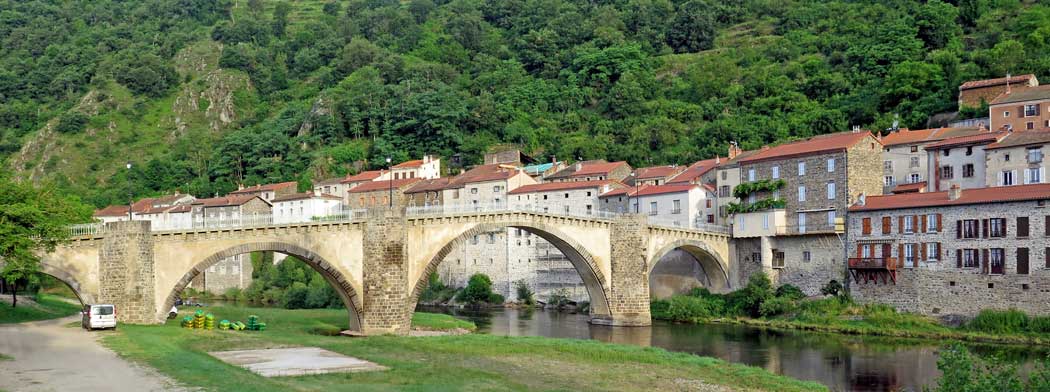
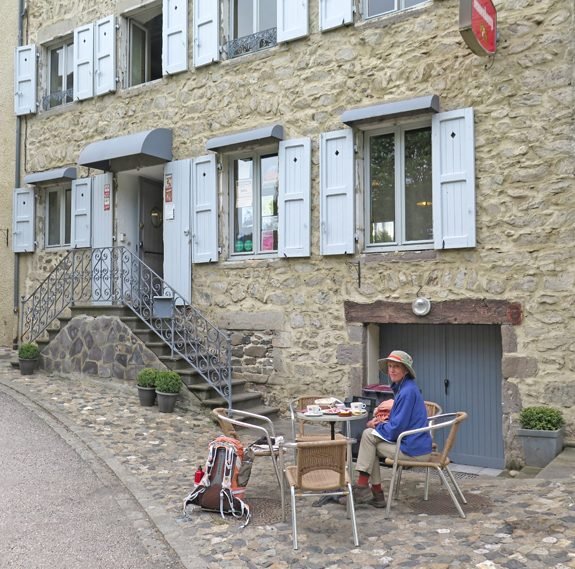
With the happy certainty that breakfast would be served at the hotel at seven, we crossed the bridge as the bells of the priory chimed the hour and went straight to the door, which was puzzlingly closed.
Peering through the glass panes, we saw someone moving about, but all our knocking could not attract their attention, The confident assurance of our waiter last night was turning out to be no more than a guess.
We wandered about for a while and then tried again, this time bringing the manager to the door.
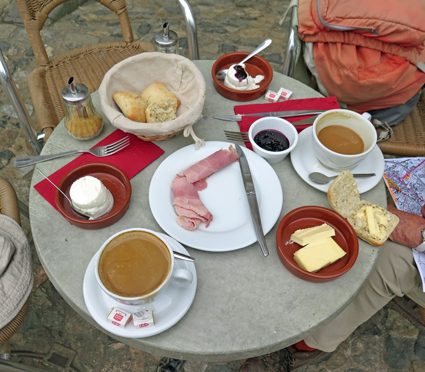
He rather brusquely told us that breakfast would not be be served until eight, and that he was very busy, but as he turned away he took pity on us and said he could give us some bread and coffee, if we sat outside.
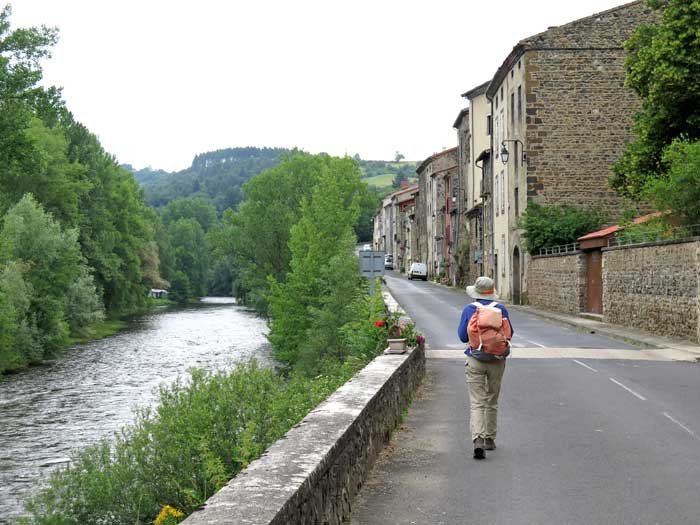
It was a bit chilly in the street but we were not complaining, and monsieur soon appeared with a tray of coffee, bread rolls, butter and jam.
Perhaps because of our fervent gratitude, he suggested that we might like some ham, and when that arrived he also brought a round of the local white cheese called “faiselle” to accompany it. In the end, it was quite a feast.
Fortified in both body and spirit, we set off on the little road beside the river for half an hour, at which point it started to climb seriously and we began to get sweeping views of the valley of the Allier, with its cloak of fields, woods and villages.
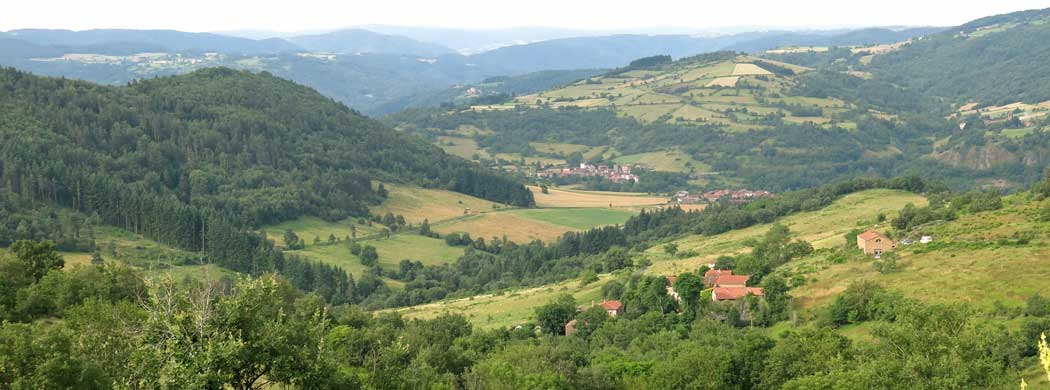
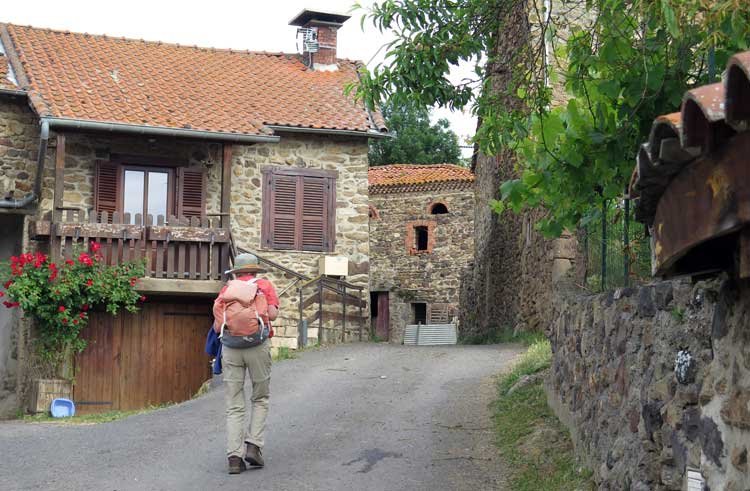
After the tiny cluster of stone houses that made up the village of Channat, we came to the top of the rise and saw a wide field stretched out below us, with a line of bluish hills behind.
Here we joined another road, which we left almost immediately, going down a wheel track towards some farm buildings.
Despite the fact that it was marked as a public way on our map, we felt uncomfortably that we were trespassing on private property, but, luckily for our nerves, there was nobody in sight.
Beyond the farm, the track descended across a great open meadow, where we lost our way in the stubble, as there were no markers to guide us.
At the bottom of the field, we had no choice but to struggle through some tangled barbed-wire fences, eventually reaching a track – not the track we were looking for, but better than no track at all.
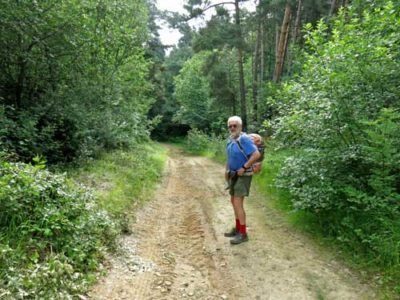
By this time we were in a forest, with the usual confusing maze of forestry roads, none of which matched our map.
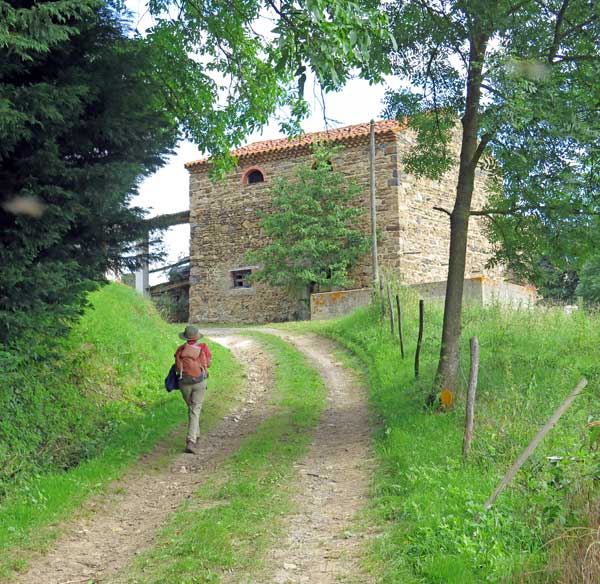
However by heading in a generally westerly direction we emerged, to our great relief, at the foot of the village of Cissac, and marched up through the deserted streets – the good citizens of this place were either sleeping in, or had gone somewhere livelier for their Sunday morning relaxation.
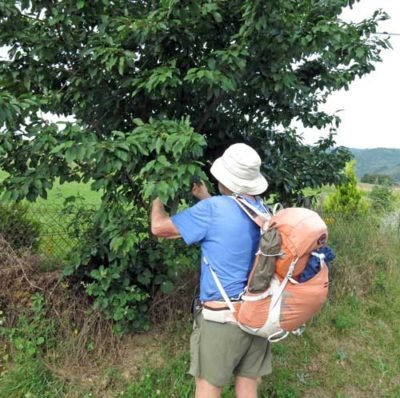
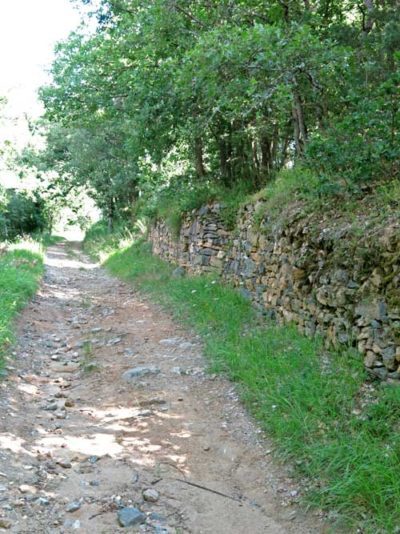
Things became much easier after that, as the route from there was marked as a GRP, plus a GR, and several other things.
We were still high above the river. A cherry tree provided a succulent snack before the bitumen gave way to a well-preserved old road, its paving still visible and a sturdy stone retaining wall standing intact.
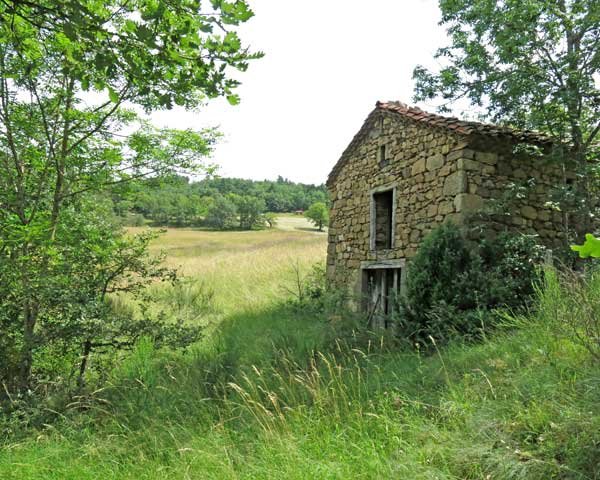
We crossed a stream and the track started to climb, but it did not agree with the route on our map. Nevertheless, we followed it trustingly and found ourselves on the ridge road near Seniquette.
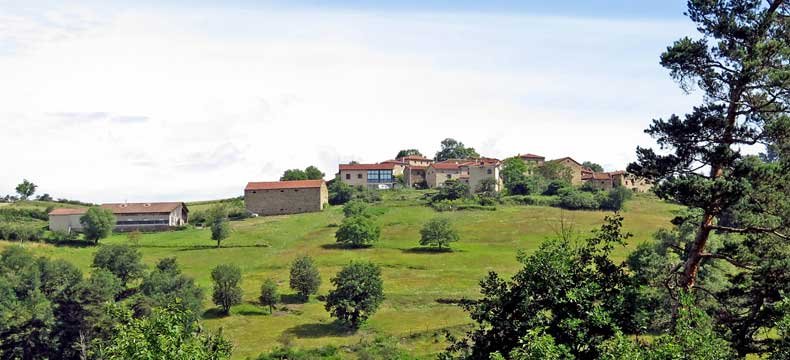
Skirting the actual village on a wheel track, we rejoined our intended track, and fell into step with a local woman, who helpfully pointed out the small path going off in the direction of Brioude.
Our immediate destination was the tiny village of Dintillat, two or three kilometres along this undulating, grassy, tree-shaded way. We had a special mission there.

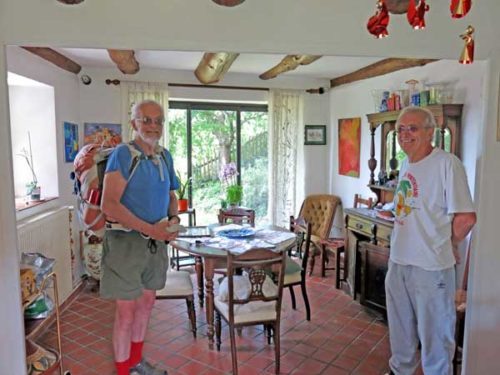
One of our daughters-in-law, Jo, had spent half a year living with a French family in Dintillat, nineteen years ago when she was a schoolgirl, but had lost contact with them. She had given us a note with their names, in the hope that we would be able to find them.
As we entered the village there was not a soul in sight, which was only to be expected at lunchtime on Sunday.
Then a car drove past and stopped at a house, so we pursued it and when the driver got out, we showed him the note, whereupon to our amazement he said yes, of course he knew them, and he would take us up to their house himself.
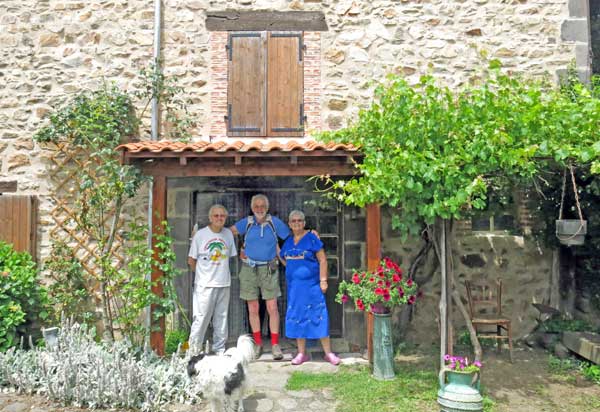
He left us at the gate and we went in to knock at the front door. A frenzy of barking preceded the appearance of an sweet-faced woman in a blue shift.
I began to explain in French why we were there, and as soon as I mentioned Joséphine, she reverted to English, with an authentic regional accent – I had forgotten what Jo had told us, that she was originally English, although her husband was born and bred in these parts.
We spent an hour talking non-stop with them, and exchanged email addresses.
We liked them very much and it was exciting and deeply satisfying for us all, to re-establish the link with Jo.
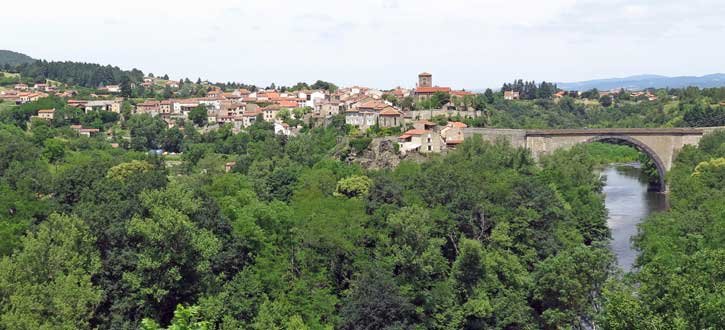
From there it was all downhill to Vieille Brioude via the bitumen road, which dived in and out of a deep side valley before crossing the Allier on a high stone bridge.
This village, now overshadowed by its bigger neighbour up the road, is on the site of the original Roman garrison guarding the river crossing on the road between Clermont-Ferrand and a settlement near le Puy. No trace of this garrison has survived.
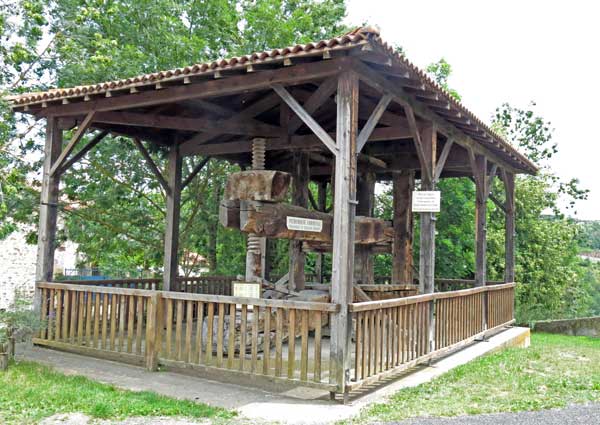
We stopped for coffee at a decidedly non-historical looking bar on the highway, close to a magnificent old wooden wine press, relic of a now vanished local industry.
Apparently the nearby slopes were covered in vines for centuries, until phylloxera wiped them out at the end of the nineteenth century.
The last part of our day’s walk was to the Brioude camping ground, which was about two kilometres down the river, on a pleasant path with a swimming area and lots of people strolling.
The camping ground was large, well-run and overflowing with campers, but we managed to find a good shady little spot for our tent.
There was a bar-restaurant a few steps away, and we were pleased to see it in operation, as the actual town of Brioude was a couple of kilometres distant, off the river.
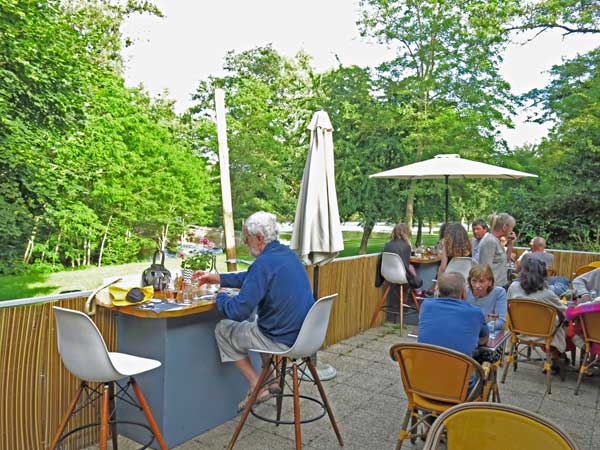
When our ablutions were done, we lay down on our mats and ate the remnants of last night’s excellent dinner – trout and bread – although the afternoon was well advanced.
This did not impair our appetite when we presented ourselves for dinner at 7:30 pm.
The restaurant had a terrace overlooking the riverside park, and we got a lovely table with a view, having taken the precaution of making a reservation earlier.
Before ordering the meal, we had a leisurely glass of rosé and enjoyed the bustle around us, as well as the peaceful scene in front.
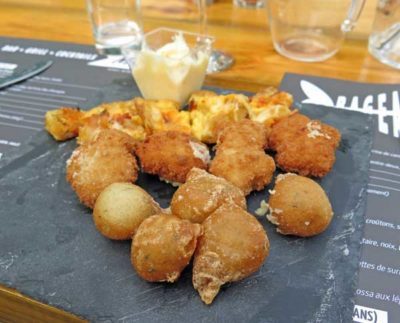
As usual, we ordered a salad as a first course, but they had run out, so we had “mixed tapas” instead, which turned out to be a collection of anonymous balls of deep-fried batter, containing we knew not what, but they were crisp and delicious.
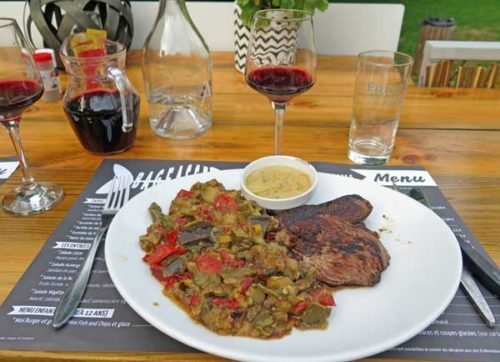
For the main course, Keith could not be swayed from his beloved steak, while I had salmon in the hope of repeating the pleasure of last night’s truite meunière (the salmon was good, but not as good).
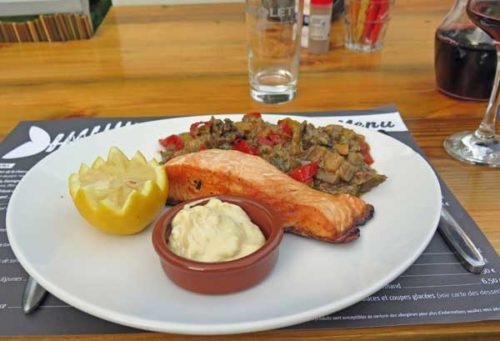
I was also swayed in my choice by the fact that the Allier was known as the “Rivière à Saumons”.
Both dishes came with a generous serve of ratatouille and a dish of sauce, and of course we had bread and wine to round out the meal in the true French manner.
Previous day: Langeac to Lavoûte-Chilhac
